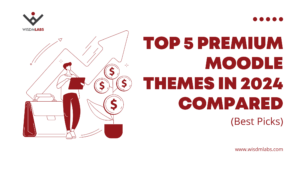eLearning is fast catching up with books and classrooms, if it already hasn’t. Having grown by over 900% in the last 15 years, learning with the help of technology is well on it’s way to becoming the new norm in our day to day lifestyle.
But with it’s advent, we’re also faced with an alarming number of misconceptions and misnomers associated with elearning. Some are virtually harmless, while others may potentially disrupt efforts one may invest in setting up a Learning Management System. Here’s a list of 5 most prevalent elearning myths, and also the facts that you can use to counter their inefficacy:

Myth: More Content Equals A Better Course
Lengthy Lessons and Modules don’t necessarily add to effectiveness of your online course. While it’s great to have detailed subject matter and well documented content, learners tend to have a very short attention span and even lesser retention when dealing with large online courses, staring at a screen day in and day out.
Microlearning is a strategy that, when applied, breaks the entire course in short sessions, to be delivered to the learner in equally short phases. What works here is that when a learner takes up a 5 minute lesson followed by a brief Q&A pertaining to the lesson, he/she tends to retain much more of the content as compared to longer lessons and rigorous quizzes.

Add in short audio/video clips and other such interactive media and the process becomes less of a study and more like play. Effortless and utterly enjoyable.
eLearning Industry has a great post on how microlearning strategies can be employed to effectively add value to your course. You can find it here.
[space]
Myth: Gamification Always Helps
The general perception of gamification in the industry is that it enhances the eLearning process.
Actively engaging users by awarding them with badges/achievements/points for successful completion of courses may be a nice way to bolster your elearning stats, but it rarely adds value to the learning process. Quality of the course is solely dependant and on the content and how effectively it’s delivered.
It’s pointless to waste resources adding gamification modules to your LMS when it’s just to add to the fun factor. They won’t just slow down the learner but also may distract him away from the truer objectives of the courses.
Related: Before Gamifying eLearning, Read This!
But when including it helps your learners understand and apply concepts better- don’t hold back! Game based learning, when applied effectively, is probably one of the most potent learning enhancers in business.
[space]
Myth: Only Instructional Designers Can Create Courses
You do not need to be a certified Instructional Designer to offer courses online. Period.
What you do need is a considerable experience and knowledge in your choice of field, the right tools to set up a course online and, well, a passion to teach.
Look at this case study by FlyPlugins, developers of WP Courseware, of the top LMS plugins on WordPress.

There have been several documented cases like these of how someone with no background in teaching has been able to set up an LMS online and earned as much as 50,000 USD a month.
How? Setting up an LMS is quick and easy when done the right way, all you need to do is put up your content and you’re all set. With the right extensions and maintenance, virtually anyone can monetize content to turn it into best selling courses and reap the benefits of online learning.
[space]
Myth: Reporting Is Secondary
This one may cost you dearly.
Often is the case that people have a full fledged LMS set-up in place, the content is flawless and the a decent number of learners have enrolled themselves for the program.
But the graph of growth has virtually come to a halt.
Why? As it turns out, a lot of instructors straight up ignore the power of statistics and LMS analytics. Reporting in an online learning ecosystem is nearly as important as the content itself, you’ve got to know how exactly your learners are interacting with the system.
Course completion rates, quizzing statistics and learner tracking; they all form a set of very essential tools that help you analyze the behaviour of your audience and upgrade your content (and the system) accordingly. For example, a low course completion rate might indicate the Course content isn’t interactive enough for a learner to stay engaged right up till the end, and hence must be updated.
Tools like Tin Can API and SCORM give you access to invaluable analytics data. However, integrating an LRS with your elearning portal can be tricky and must be done with utmost care. (That’s where we step in.)
Reporting is never secondary.
[space]
Myth: eLearning Is For The Casual Learner
Probably the biggest of all them misconceptions. eLearning is often perceived as an option that is second to actually going to a physical classroom to learn. Also the general belief that a certification in an online course isn’t as weighty as the one you obtain from traditional full time courses.
It’s far from true.

Online classes are run by real people. People who are available via email, chat, text, or Skype. Who keep track of each and every lesson or module that you complete and validate your learning with proper tests and assessment.
It’s low on effort and high on impact. Apart from that, eLearning can be extremely personalized.
It can adapt to varying schedules, timings and even physiological challenges and disabilities that a learner might face in life. Learning in groups and collaborating with others on a daily basis may not be everyone’s mug of coffee. Online courses provide you with the quiet you need to learn and also collaborate with others like on dedicated social media.
There could be a thousand more such vindications that you need to keep in mind for a successful career in elearning, but I figured that when generalized, these five could very well take care of almost all of those. Did I miss out on something important that ought to be on list? Let me know in the comments section!










